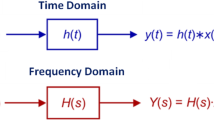Abstract
A physical structure might show undesired forced vibrations when excited by a specific force signal. Moreover, if the resulting deflections influence the acting force, undesired self-excited vibrations can result. In such cases a usual approach is to modify the structure by mounting passive tuned mass dampers (TMD). Different strategies are available to design such TMD. The different approaches have in common, that the original structure is approximated as a single degree of freedom (SDOF) system. This approximation limits the applicability of the design strategies. This paper attempts to solve the abovementioned drawback. Based on a frequency domain substructure coupling approach, it is proposed to apply a sequential quadratic programming algorithm to determine effective parameters of TMD. The approach considers the multiple degrees of freedom (MDOF) character of the original structure. The new method is evaluated by means of a simple finite element model of a simplified milling machine assembly. By means of this analytical example, it is shown that both SDOF TMD and MDOF TMD can be parameterized by the new method. The practical applicability is proven by designing a STMD for a linear axis test bench. Finally, limitations of the method and reasonable subsequent research tasks are discussed.










Similar content being viewed by others
References
Altintas Y, Weck M (2004) Chatter stability of metal cutting and grinding. CIRP Ann Manuf Technol 53(2):619–642. doi:10.1016/S0007-8506(07)60032-8
Bajpai VK, Garg TK, Gupta MK (2007) Vibration-dampers for smoke stacks. In: 3rd WSEAS international conference on applied and theoretical mechanics, Spain, pp 124–130
Brecher C, Bäumler S, Brockmann B (2013) Hilfsmassendämpfer für Werkzeugmaschinen. Optimierte Auslegung passiver Hilfsmassendämpfer zur Stabilisierung von Bearbeitungsprozessen. Werkstattstech Online 5:395–401
Brecher C, Schmidt S, Fey M (2015) On the integration of tuned multi-mass dampers into a topology optimization method for machine tool structural dynamics. In: 11th world congress on structural and multidisciplinary optimization. Sydney
Brecher C, Fey M, Tenbrock C, Daniels M (2015) Multipoint constraints for modeling of machine tool dynamics. J Manuf Sci Eng. doi:10.1115/1.4031771
Brock JE (1946) A note on the damped vibration absorber. Trans ASME J Appl Mech 13(4):A-284
Conn AR, Gould NIM, Toint PL (2000) Trust-region methods, society for industrial and applied mathematics. Philadelphia. doi:10.1137/1.9780898719857
Ewins DJ (2000) Modal testing: theory, practice and application, 2nd edn. Research Studies Press, Baldock Hertfordshire, England, Philadelphia
Glover F (1998) A template for scatter search and path relinking. In: Hao J, Lutton E, Ronald E, Schoenauer M, Snyers D (eds) Artificial evolution. Springer, Berlin Heidelberg, pp 1–51. doi:10.1007/BFb0026589
Han SP (1977) A globally convergent method for nonlinear programming. J Optim Theory Appl 22(3):297–309. doi:10.1007/BF00932858
Den Hartog JP (1934) Mechanical vibrations. Dover Publ, New York
Heirman GHK, Desmet W (2010) Interface reduction of flexible bodies for efficient modeling of body flexibility in multibody dynamics. Multibody Syst Dyn 24(2):219–234. doi:10.1007/s11044-010-9198-7
Joshi AS, Jangid RS (1997) Optimum parameters of multiple tuned mass dampers for base-excited damped systems. J Sound Vib 202(5):657–667. doi:10.1006/jsvi.1996.0859
Keinänen J, Tammi K, Sainio H (2013) Adjustable tuned mass damper concept for a diesel generator. MTZ Ind 3(2):44–49. doi:10.1007/s40353-013-0098-1
de Klerk D, Rixen DJ, Voormeeren SN (2008) General framework for dynamic substructuring: history, review and classification of techniques. AIAA J 46(5):1169–1181. doi:10.2514/1.33274
Li H-N, Ni X-L (2007) Optimization of non-uniformly distributed multiple tuned mass damper. J Sound Vib 308(1–2):80–97. doi:10.1016/j.jsv.2007.07.014
Liu GR, Quek SS (2003) The finite element method: a practical course. Butterworth-Heinemann, Oxford, Boston
MathWorks (2015) Optimization toolbox: user’s guide. R2015b. http://www.mathworks.com/help/pdf_doc/optim/optim_tb.pdf. Accessed 08 Feb 2016
MathWorks (2015) Global optimization toolbox: user’s guide. R2015b. http://www.mathworks.com/help/pdf_doc/gads/gads_tb.pdf. Accessed 08 Feb 2016
Nocedal J, Wright SJ (1999) Numerical optimization. Springer, New York
Powell MJD (1978) A fast algorithm for nonlinearly constrained optimization calculations. In: Watson GA (ed) Numerical analysis. Springer, Berlin Heidelberg, pp 144–157. doi:10.1007/BFb0067703
Sims ND (2007) Vibration absorbers for chatter suppression: a new analytical tuning methodology. J Sound Vib 301(3–4):592–607. doi:10.1016/j.jsv.2006.10.020
Ugray Z, Lasdon L, Plummer J, Glover F, Kelly J, Martí R (2007) Scatter search and local NLP solvers: a multistart framework for global optimization. INFORMS J Comput 19(3):328–340. doi:10.1287/ijoc.1060.0175
Wagner H, Ramamurti V, Sastry R, Hartmann K (1973) Dynamics of stockbridge dampers. J Sound Vib 30(2):207–220. doi:10.1016/S0022-460X(73)80114-2
Webster AC, Vaicaitis R (1992) Application of tuned mass dampers to control vibrations of composite floor system. Eng J Am Inst Steel Constr 29(3):116–124
Weck M, Brecher C (2006) Werkzeugmaschinen Konstruktion und Berechnung. Springer, Berlin
Wilson RB (1963) A simplicial algorithm for concave programming, Ph.D. Thesis, Harvard University, Cambridge
Yang Y, Muñoa J, Altintas Y (2010) Optimization of multiple tuned mass dampers to suppress machine tool chatter. Int J Mach Tools Manuf 50(9):834–842. doi:10.1016/j.ijmachtools.2010.04.011
Zuo L, Nayfeh SA (2003) Optimization of the individual stiffness and damping parameters in multiple-tuned-mass-damper systems. Smart Struct Mater Proc SPIE 5052:217–229. doi:10.1117/12.483798
Acknowledgments
The authors would like to thank the German Research Foundation DFG for the financial support in the project BR2905/55-1. The results presented in this paper have been worked out in this project.
Author information
Authors and Affiliations
Corresponding author
Rights and permissions
About this article
Cite this article
Brecher, C., Fey, M. & Daniels, M. Substructure coupling approach to parameterization of passive dynamic auxiliary systems. Prod. Eng. Res. Devel. 10, 351–360 (2016). https://doi.org/10.1007/s11740-016-0669-4
Received:
Accepted:
Published:
Issue Date:
DOI: https://doi.org/10.1007/s11740-016-0669-4




